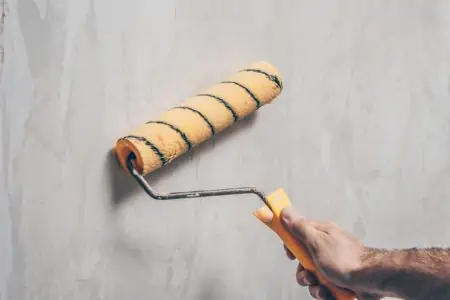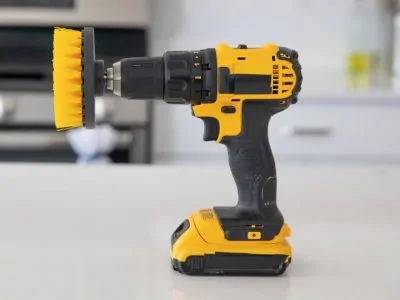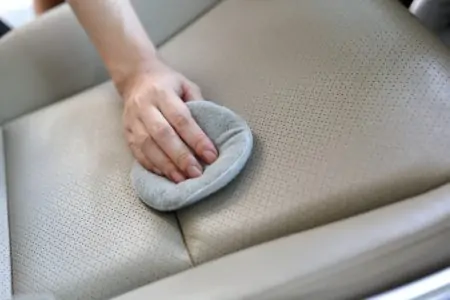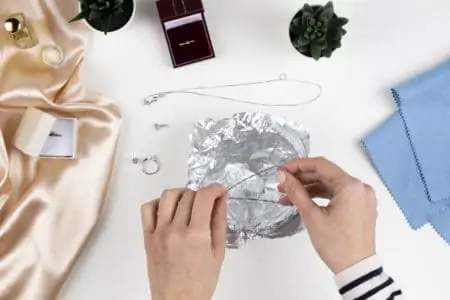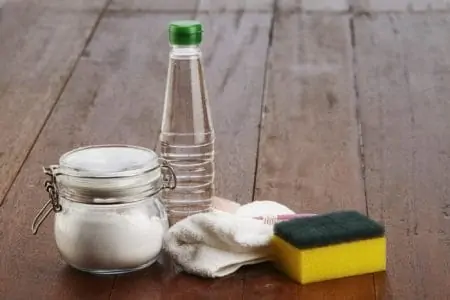We know cleaning your paint rollers is the last thing on your mind after spending hours painting a room. But if you don’t clean them promptly and properly, you could ruin the paint rollers. If you have a few days of painting ahead, you want them to leave them in a good condition, so that you don’t need to buy new ones for every room!
We’ll show you how to clean paint rollers using our handy step-by-step guide. We’ll also show you how to restore dried paint rollers and clean paint roller trays. Everything you need to know about paint rollers is just a scroll away!
Key Takeaways
- Clean paint rollers after each use to maintain their condition and prevent damage.
- Use mineral spirits to clean oil-based paint and dish soap for latex paint off rollers.
- Restore dried paint rollers by soaking them in specialized brush cleaner or distilled white vinegar.
- Always air dry paint rollers vertically to avoid flattening the fibers.
Do You Wash Paint Rollers After Every Use?
You should wash your paint rollers after each use and painting session. You do not need to wash the paint roller if you’re taking a short break or moving on to your next coat. Instead, pop it in a plastic bag and tie it around the handle. This stops the paint from drying out and hardening on the roller. You should also preserve the paint tray in a plastic bag.
How to Clean Oil-Based Paint Off Rollers
Let’s start with how to remove oil-based paint from your rollers, which is a bit more tricky than latex paint. This method is without paint thinner. Instead, we’ll be using mineral spirits or white spirits.
- Time: 40 minutes
- Difficulty: Intermediate
What You’ll Need
- Mineral spirits (often known as white spirits)
- Rag or cloth
- Bucket
- Rubber gloves
- Disposable container
- Dish soap
- Putty knife
1. Remove Excess Paint
It’s important not to waste excess paint. Hold your roller over your paint tin and use a putty knife to scrape off excess paint. Even if you’re not bothered about keeping the excess paint, this step is crucial as it makes cleaning easier.
2. Prepare Cleaning Solution
Use as small a bucket as possible (but big enough to submerge the paint roller) and fill it with white spirits. The reason for using a small bucket is so that you don’t use too much mineral spirits.
3. Remove the Roller Brush
We will clean the brush separately from the paint tray and roller handle. Wearing your rubber gloves, remove the roller brush. Place it in the mineral spirits.
4. Clean Paint From Roller
Wearing gloves, use your hands to scrub the solvent through the paint roller. This takes around 10 minutes, so have patience. Once you’ve agitated every part of the roller, remove it from the solvent and squeeze it gently to remove excess liquid.
Pour the mineral spirits from the bucket into a disposable container. Use a rag to wipe out the bucket. Refill with more mineral spirits. Rinse the roller in the spirits, remove it and squeeze the excess liquid out. Pour the mineral spirits into the disposable container again and wipe the bucket out with a rag again too.
5. Wash Roller With Soap
Fill the bucket with warm water and a few drops of dish soap. Submerge the roller in the foamy water and agitate it to remove any excess paint and solvent.
6. Rinse the Roller
Rinse the roller under running water. Squeeze out excess liquid.
7. Air Dry
Place the roller in a vertical position on a drying rack to air dry. You can also hang it up to air dry. If it’s a warm day, hang it outside to speed up the drying process.
Dispose Of Containers
We asked you to place the mineral spirit solution in disposable containers rather than pouring it down the sink. You will need to dispose of the containers in accordance with your local area’s guidelines.
How to Clean Latex Paint Off Of Rollers
Latex paint is a bit easier to clean. Many brands now use latex-based paint over oil, including Kilz, Recolor, and Prestige.
But you need to remember not to pour the cleaning water down the stormwater drains. Instead, always pour it down a sewer drain connected to a water-treatment facility. Check your local guidelines for more information.
- Time: 25 minutes
- Difficulty: Easy
What You’ll Need
- Putty knife
- Rubber gloves
- Bucket
- Dish soap
1. Remove Excess Paint
Use your putty knife to scrape excess paint from the roller back into the can. This saves your excess paint and makes cleaning the roller easier.
2. Prepare Cleaning Solution
In your bucket, prepare warm water with a few drops of dish soap, so the water is bubbly.
3. Remove Roller From Frame
Take the roller off its handle for the next steps. We will clean the handle and tray separately later.
4. Wash the Roller
Submerge the roller in warm soapy water. Wear your rubber gloves and massage the roller to clean every part of it and remove the paint. This could take 5-10 minutes. You might think a sponge could help, but your gloved hands are going to be more effective.
5. Rinse the Roller
Hold the roller under your tap and rinse it with fresh water. This can take a few minutes to eliminate all the paint and soap residue. Squeeze out excess water.
6. Dry the Roller
Place the roller vertically on a drying rack or hang it up to dry. Never dry it flat as this can flatten the fibers.
Once you’re done, dispose of the soapy water down a sewer drain, not a stormwater drain.
How to Restore Dried Paint Rollers
Uh-oh. You left paint on your roller, and now it’s hard, dry, and impossible to use. Do you toss these rollers out, or is there any hope? We think you can restore them, so let’s give it a go! This works for all types of rollers including sponge or foam.
Note that this method works for dried paint brushes, too.
- Time: 1 hour
- Difficulty: Intermediate
What You’ll Need
- Bucket
- Specialized brush cleaner or distilled white vinegar
- Rubber gloves
- Soft-bristled brush
- Paint roller comb
- Sink
- Towel
1. Soak the Roller
Put the roller in a bucket and fill it with specialized brush cleaner or distilled white vinegar. You might need quite a lot to submerge the roller fully. Leave it for the recommended time on the packaging instructions, or 1-2 hours if cleaning with vinegar.
Vinegar Tip
If, after a couple of hours, the vinegar isn’t loosening the paint, you can transfer the vinegar and roller to a pot. Bring the pot to a boil on the stove. Once it starts to bubble, remove the pot and let it cool down. The warm vinegar is more effective.
2. Scrub the Roller
Wearing rubber gloves, use your soft-bristled brush to scrub the roller gently. The loosened paint will come off. Continue until the roller is clean. This can take around 20 minutes, so be patient.
3. Rinse and Squeeze
Run the roller under clean water to rinse out the paint and cleaning solution residue. You can scrub the roller as you do this with your soft-bristled brush. After you’ve rinsed the roller, squeeze the roller to remove excess water.
4. Comb the Fibers
To fluff the fibers back into the original shape, use a paint roller comb to brush them gently. This can also remove any extra dried-on paint.
5. Check It’s Clean
Submerge the brush into a bucket of clean water. If the water is still dirty, repeat the above steps. If not, you’re good to go!
6. Dry the Roller
Before you use the roller again, make sure it’s dry. Squeeze out excess water, blot with a towel, and hang it up to air dry. You can also stand it vertically on a drying rack.
How to Clean Paint Roller Trays
We can’t leave you without instructions for cleaning paint roller trays. We’ll also show you how to clean the handles and frame.
- Time: 20 minutes
- Difficulty: Easy/Intermediate
What You’ll Need
- Rubber gloves
- Bucket
- Dish soap
- Cloth
- Stiff-bristled brush
- Towel
- Mineral spirits (for oil-based paint)
1. Remove Excess Paint
If you still have paint in the tray, pour it back into the paint can.
2. Prepare Cleaning Solution
For water-based and latex paint, fill a bucket with warm water and a few drops of dish soap until the water is bubbly.
If cleaning oil-based paint, dampen a cloth with mineral spirits.
3. Clean Tray and Roller Frame
For water-based paint, you can submerge the tray and frame into the soapy water and scrub it clean with a stiff-bristled brush. Continue until the two items are visibly clean.
With oil-based paint, wipe the tray and frame down with your mineral-spirit-soaked rag. Scrub well to remove any dried paint. You can also use a stiff-bristled brush to remove stubborn paint.
4. Rinse
Once the tray and frame are clean, rinse them under warm water to remove soap residue.
5. Dry
Use a towel to wipe the tray and frame dry. Leave it out for a couple of hours to fully air dry.
How to Store Rollers Between Uses
If you are taking a short break (up to two days), you don’t need to clean the rollers. But you also don’t want the paint to dry either. Place the rollers into a plastic bag and tie it around the handle. You can place the paint tray into a separate plastic bag.
You can further preserve the paint by putting it in the freezer after you’ve wrapped it in a plastic bag.
Paint Roller Cleaning Hacks
Some extra tips you might appreciate include:
- Rinse the inside: When you take your roller off the frame, you might have paint inside the roller. Rinse that out well, so it’s easier to place the roller back onto the frame next time you use it.
- Leave to rinse: If your roller is taking forever to wash clean, you can stand it up in the sink under running water and just walk away. Aim the water down the hollow middle of the roller, and it will eventually spill over the sides and trickle down, rinsing the roller while you sit back and relax. After a few minutes, flip the roller and repeat. Don’t do this for oil-based paint, as you don’t want it to go down the drain.
- Clean immediately: After you finish painting, clean your rollers right away to minimize the risk of the paint hardening.
- Always remove excess paint: Don’t skip this step. Removing excess paint from your roller with a putty knife or flat metal spatula is crucial to getting a more effortless clean.
- Use a hose: If you want higher water pressure to clean the rollers quicker, rinse them under your garden hose. Make sure that you’re in a safe area and that the paint won’t affect the landscape and environment around you. But seriously, this can speed up your cleaning time!
How to Dry a Paint Roller
It’s important to air dry your paint roller in a vertical position. You never want to lay it on its side as this will flatten the fibers.
If you can’t stand it vertically, a great hack is to hang it over a pants hanger. Pop it outside on a warm day to air dry.
In our experience, it can take up to 24 hours for the paint roller to air dry fully. It’s important to wait until it’s 100 percent dry. Otherwise, it can dilute your paint and leave you with a splotchy uneven finish the next time you paint.
FAQs
Ready to Roll
Now that you know how to wash paint rollers, they’re ready for reuse. You might have heard of various hacks, but this cleaning method is the safest and most effective.
Always ensure that you follow the correct instructions depending on the type of paint you have. For instance, always clean oil-based paint with mineral spirits. Clean latex paint with dish soap.
Are you ready to clean your rollers and enjoy your freshly painted room? Give it a try!
